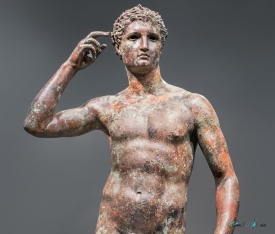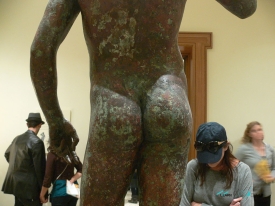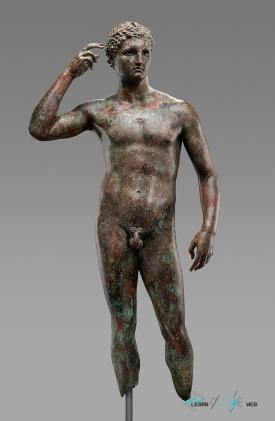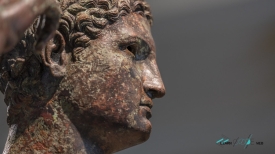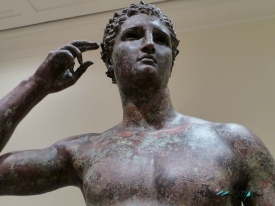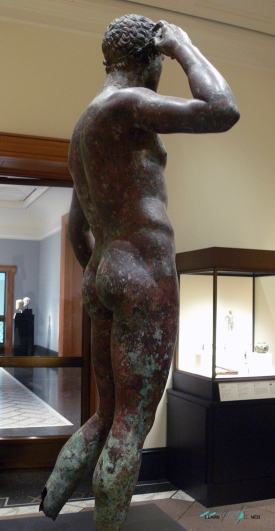In the world of art, few stories resonate as profoundly as that of The Victorious Youth, a Greek bronze sculpture steeped in controversy and coveted by nations. Also known as Atleta di Fano or Lisippo di Fano, this masterpiece emerged from the depths of the Mediterranean Sea in 1964, ensnared in the nets of an Italian fishing trawler. Crafted between 300 and 100 BC, it embodies the essence of ancient Greek athleticism and artistic mastery.
The journey of The Victorious Youth began with its fortuitous discovery off the Adriatic coast near Fano, Italy. Snagged in the nets of the Ferri Ferruccio, an Italian fishing vessel, it was thrust into the limelight of the art world. Italian art dealers swiftly seized upon this extraordinary find, setting off a chain of events that would shape its destiny.
Italian art dealers acquired it from the fishermen for $5,600 USD. In 1977, the Getty Museum purchased it for almost $4M USD from German art dealer Herman Heinz Herzer. Found amidst a trove of underwater bronzes along the Aegean and Mediterranean coasts, its precise shipwreck location remains a mystery, though it likely sank en route to Italy on a Roman vessel laden with looted objects. Covered in incrustation hinting at a pre-medieval origin, the statue's restoration, spearheaded by conservationist Rudolph Stapp, involved meticulous cleaning over three months. The process included submersion in a heated solution to counter bronze disease—a corrosive reaction to chloride and moisture—ensuring the preservation of this ancient masterpiece.
After decades of legal wrangling, Italy scored a significant victory in its quest for repatriation. In a landmark ruling, the European Court of Human Rights affirmed Italy's right to reclaim The Victorious Youth, citing the need to protect cultural heritage and rectify past injustices. This ruling marked a watershed moment in the ongoing debate over the restitution of looted artifacts.
As Italy's quest for repatriation continues, The Victorious Youth serves as a poignant symbol of the enduring struggle to preserve cultural heritage. Its journey from the depths of the sea to the center of a legal maelstrom underscores the importance of ethical stewardship and the protection of our shared history. Beyond the confines of legal battles and diplomatic negotiations, it stands as a beacon of hope for the restitution of looted artifacts and the preservation of cultural identity.
The journey of The Victorious Youth began with its fortuitous discovery off the Adriatic coast near Fano, Italy. Snagged in the nets of the Ferri Ferruccio, an Italian fishing vessel, it was thrust into the limelight of the art world. Italian art dealers swiftly seized upon this extraordinary find, setting off a chain of events that would shape its destiny.
Italian art dealers acquired it from the fishermen for $5,600 USD. In 1977, the Getty Museum purchased it for almost $4M USD from German art dealer Herman Heinz Herzer. Found amidst a trove of underwater bronzes along the Aegean and Mediterranean coasts, its precise shipwreck location remains a mystery, though it likely sank en route to Italy on a Roman vessel laden with looted objects. Covered in incrustation hinting at a pre-medieval origin, the statue's restoration, spearheaded by conservationist Rudolph Stapp, involved meticulous cleaning over three months. The process included submersion in a heated solution to counter bronze disease—a corrosive reaction to chloride and moisture—ensuring the preservation of this ancient masterpiece.
Legal Battles and International Controversy
However, the elation surrounding the acquisition soon gave way to controversy. Allegations of illegal exportation and cultural heritage theft cast a shadow over the sculpture's provenance. Italy, laying claim to its cultural heritage, embarked on a protracted legal battle to reclaim what it deemed rightfully theirs.After decades of legal wrangling, Italy scored a significant victory in its quest for repatriation. In a landmark ruling, the European Court of Human Rights affirmed Italy's right to reclaim The Victorious Youth, citing the need to protect cultural heritage and rectify past injustices. This ruling marked a watershed moment in the ongoing debate over the restitution of looted artifacts.
Artistry in Bronze
Crafted through the intricate lost-wax method, The Victorious Youth stands as a testament to the skill and ingenuity of ancient Greek artisans. Its lifelike depiction of a youthful athlete, poised in triumph, captivates viewers with its exquisite detail and timeless beauty. From the sinewy muscles to the delicate features, every aspect of the sculpture speaks to the mastery of its creator.As Italy's quest for repatriation continues, The Victorious Youth serves as a poignant symbol of the enduring struggle to preserve cultural heritage. Its journey from the depths of the sea to the center of a legal maelstrom underscores the importance of ethical stewardship and the protection of our shared history. Beyond the confines of legal battles and diplomatic negotiations, it stands as a beacon of hope for the restitution of looted artifacts and the preservation of cultural identity.



